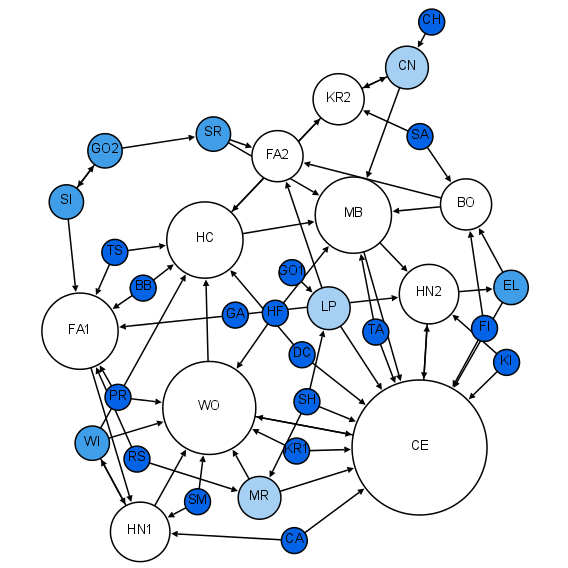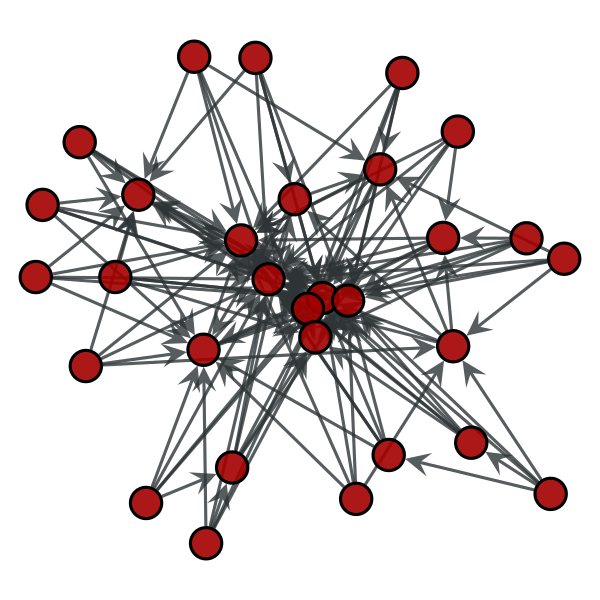|
Network Formation
Network formation is an aspect of network science that seeks to model how a network evolves by identifying which factors affect its structure and how these mechanisms operate. Network formation hypotheses are tested by using either a dynamic model with an increasing network size or by making an agent-based model to determine which network structure is the equilibrium in a fixed-size network. Dynamic models A dynamic model, often used by physicists and biologists, begins as a small network or even a single node. The modeler then uses a (usually randomized) rule on how newly arrived nodes form links in order to increase the size of the network. The aim is to determine what the properties the network will be when it grows in size. In this way, researchers try to reproduce properties common in most real networks, such as the small world network property or the scale-free network property. These properties are common in almost every real network including the World Wide Web, the met ... [...More Info...] [...Related Items...] OR: [Wikipedia] [Google] [Baidu] |
Network Science
Network science is an academic field which studies complex networks such as telecommunication networks, computer networks, biological networks, cognitive and semantic networks, and social networks, considering distinct elements or actors represented by ''nodes'' (or ''vertices'') and the connections between the elements or actors as ''links'' (or ''edges''). The field draws on theories and methods including graph theory from mathematics, statistical mechanics from physics, data mining and information visualization from computer science, inferential modeling from statistics, and social structure from sociology. The United States National Research Council defines network science as "the study of network representations of physical, biological, and social phenomena leading to predictive models of these phenomena." Background and history The study of networks has emerged in diverse disciplines as a means of analyzing complex relational data. The earliest known paper in this f ... [...More Info...] [...Related Items...] OR: [Wikipedia] [Google] [Baidu] |
World Wide Web
The World Wide Web (WWW), commonly known as the Web, is an information system enabling documents and other web resources to be accessed over the Internet. Documents and downloadable media are made available to the network through web servers and can be accessed by programs such as web browsers. Servers and resources on the World Wide Web are identified and located through character strings called uniform resource locators (URLs). The original and still very common document type is a web page formatted in Hypertext Markup Language (HTML). This markup language supports plain text, images, embedded video and audio contents, and scripts (short programs) that implement complex user interaction. The HTML language also supports hyperlinks (embedded URLs) which provide immediate access to other web resources. Web navigation, or web surfing, is the common practice of following such hyperlinks across multiple websites. Web applications are web pages that function as application s ... [...More Info...] [...Related Items...] OR: [Wikipedia] [Google] [Baidu] |
Utility Function
As a topic of economics, utility is used to model worth or value. Its usage has evolved significantly over time. The term was introduced initially as a measure of pleasure or happiness as part of the theory of utilitarianism by moral philosophers such as Jeremy Bentham and John Stuart Mill. The term has been adapted and reapplied within neoclassical economics, which dominates modern economic theory, as a utility function that represents a single consumer's preference ordering over a choice set but is not comparable across consumers. This concept of utility is personal and based on choice rather than on pleasure received, and so is specified more rigorously than the original concept but makes it less useful (and controversial) for ethical decisions. Utility function Consider a set of alternatives among which a person can make a preference ordering. The utility obtained from these alternatives is an unknown function of the utilities obtained from each alternative, not the sum of ... [...More Info...] [...Related Items...] OR: [Wikipedia] [Google] [Baidu] |
Game Theory
Game theory is the study of mathematical models of strategic interactions among rational agents. Myerson, Roger B. (1991). ''Game Theory: Analysis of Conflict,'' Harvard University Press, p.&nbs1 Chapter-preview links, ppvii–xi It has applications in all fields of social science, as well as in logic, systems science and computer science. Originally, it addressed two-person zero-sum games, in which each participant's gains or losses are exactly balanced by those of other participants. In the 21st century, game theory applies to a wide range of behavioral relations; it is now an umbrella term for the science of logical decision making in humans, animals, as well as computers. Modern game theory began with the idea of mixed-strategy equilibria in two-person zero-sum game and its proof by John von Neumann. Von Neumann's original proof used the Brouwer fixed-point theorem on continuous mappings into compact convex sets, which became a standard method in game theory and mathema ... [...More Info...] [...Related Items...] OR: [Wikipedia] [Google] [Baidu] |
Preferential Attachment
A preferential attachment process is any of a class of processes in which some quantity, typically some form of wealth or credit, is distributed among a number of individuals or objects according to how much they already have, so that those who are already wealthy receive more than those who are not. "Preferential attachment" is only the most recent of many names that have been given to such processes. They are also referred to under the names Yule process, cumulative advantage, the rich get richer, and the Matthew effect. They are also related to Gibrat's law. The principal reason for scientific interest in preferential attachment is that it can, under suitable circumstances, generate power law distributions. If preferential attachment is non-linear, measured distributions may deviate from a power law. These mechanisms may generate distributions which are approximately power law over transient periods. Definition A preferential attachment process is a stochastic urn process, ... [...More Info...] [...Related Items...] OR: [Wikipedia] [Google] [Baidu] |
Lattice Graph
In graph theory, a lattice graph, mesh graph, or grid graph is a graph whose drawing, embedded in some Euclidean space , forms a regular tiling. This implies that the group of bijective transformations that send the graph to itself is a lattice in the group-theoretical sense. Typically, no clear distinction is made between such a graph in the more abstract sense of graph theory, and its drawing in space (often the plane or 3D space). This type of graph may more shortly be called just a lattice, mesh, or grid. Moreover, these terms are also commonly used for a finite section of the infinite graph, as in "an 8 × 8 square grid". The term lattice graph has also been given in the literature to various other kinds of graphs with some regular structure, such as the Cartesian product of a number of complete graphs. Square grid graph A common type of a lattice graph (known under different names, such as square grid graph) is the graph whose vertices correspond to the p ... [...More Info...] [...Related Items...] OR: [Wikipedia] [Google] [Baidu] |
Watts And Strogatz Model
Watts is plural for ''watt'', the unit of power. Watts may also refer to: People *Watts (surname), list of people with the surname Watts Fictional characters *Watts, main character in the film '' Some Kind of Wonderful'' *Watts family, six characters in the TV series ''EastEnders'' *Curly Watts, in the ITV soap opera ''Coronation Street'' * Peter Watts, in the TV series ''Millennium'' * Raquel Watts, in the ITV soap opera ''Coronation Street'' *Wade Owen Watts, protagonist in the novel ''Ready Player One'' and its film adaption. Places United Kingdom * Watts Bank, a nature reserve in Berkshire, England. * Watts Hill, Dorset, England. * Watts Mortuary Chapel, Surrey, England * Watts Naval School, Norfolk, England * Watts Warehouse, Manchester, England United States * Watts, Los Angeles, California, a city district ** Watts, California, former city that was supplanted by Watts, Los Angeles ** Watts Station, historic train station in Watts, Los Angeles ** Watts Towers, 17 sculp ... [...More Info...] [...Related Items...] OR: [Wikipedia] [Google] [Baidu] |
Metabolic Network
A metabolic network is the complete set of metabolic and physical processes that determine the physiological and biochemical properties of a cell. As such, these networks comprise the chemical reactions of metabolism, the metabolic pathways, as well as the regulatory interactions that guide these reactions. With the sequencing of complete genomes, it is now possible to reconstruct the network of biochemical reactions in many organisms, from bacteria to human. Several of these networks are available online: Kyoto Encyclopedia of Genes and Genomes (KEGG), EcoCyc, BioCyc and metaTIGER. Metabolic networks are powerful tools for studying and modelling metabolism. Uses Metabolic networks can be used to detect comorbidity patterns in diseased patients. Certain diseases, such as obesity and diabetes, can be present in the same individual concurrently, sometimes one disease being a significant risk factor for the other disease. The disease phenotypes themselves are normally the conseque ... [...More Info...] [...Related Items...] OR: [Wikipedia] [Google] [Baidu] |
Scale-free Network
A scale-free network is a network whose degree distribution follows a power law, at least asymptotically. That is, the fraction ''P''(''k'') of nodes in the network having ''k'' connections to other nodes goes for large values of ''k'' as : P(k) \ \sim \ k^\boldsymbol where \gamma is a parameter whose value is typically in the range 2<\gamma<3 (wherein the second moment () of is infinite but the first moment is finite), although occasionally it may lie outside these bounds. Many networks have been reported to be scale-free, although statistical analysis has refuted many of these claims and seriously questioned others. Additionally, some have argued that simply knowing that a degree-distribution is [...More Info...] [...Related Items...] OR: [Wikipedia] [Google] [Baidu] |
Network Topology
Network topology is the arrangement of the elements ( links, nodes, etc.) of a communication network. Network topology can be used to define or describe the arrangement of various types of telecommunication networks, including command and control radio networks, industrial fieldbusses and computer networks. Network topology is the topological structure of a network and may be depicted physically or logically. It is an application of graph theory wherein communicating devices are modeled as nodes and the connections between the devices are modeled as links or lines between the nodes. Physical topology is the placement of the various components of a network (e.g., device location and cable installation), while logical topology illustrates how data flows within a network. Distances between nodes, physical interconnections, transmission rates, or signal types may differ between two different networks, yet their logical topologies may be identical. A network’s physical topology is ... [...More Info...] [...Related Items...] OR: [Wikipedia] [Google] [Baidu] |




